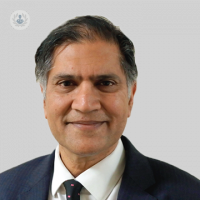Silencing middle ear myoclonus (Part one)
Autore:The inner-ear noises that people with middle ear myoclonus (MEM) experience can be so severe that they’re unable to sleep. Learning to live with the symptoms may not be practical for those with such debilitating effects, so what can be done to solve the problem?
In the first part of a double series of articles, one of the UK’s leading otologists, Professor Manohar Bance, provides a comprehensive answer to this question. He discusses the ins and outs of middle ear myoclonus in expert detail.
In part two, you can find out more about diagnosis, treatment and management of middle ear myoclonus.

What is middle ear myoclonus?
MEM is the involuntary contraction of the muscles in the middle ear, specifically the tensor tympani, and the stapedius muscles. It is not really clear what these muscles do normally. The stapedius contracts in response to loud sound, and possibly might be useful to protect the inner ear from noise, but it is controversial how effective this is.
The tensor tympani doesn’t contract in response to noise, normally, and it is unclear what, if any, role it has in humans. It might be left over from different use in other species, but has evolved, like the appendix, to have little role in humans.
What are the signs of middle ear myoclonus?
Signs can be crackling, clicking or thumping noises in the ear, as well as fluttering in the ear. These may be severe enough to prevent sleep, and are often triggered by sound, and sometimes by scratching of the face. The thumps are usually irregular, and not in time with the heartbeat. The fluttering might be more associated with the stapedius muscle, and can often be felt as much as heard.
Is it a symptom associated with other conditions?
It has to be distinguished from other conditions such as palatal myoclonus or typewriter tinnitus, as well as eustachian tube disorders.
Palatal myoclonus is a neurological condition that can cause a clicking sound in the ears, and is often present all the time, instead of coming and going. It is caused by the muscles in the palate (soft part at the back of the throat when you open your mouth) contracting rhythmically, which opens and closes the eustachian tube. This is what is heard. It is not helped by cutting the tensor tympani tendon, but is treated with Botox© injections into the palate.
The eustachian tube connects the back of the nose to the middle ear, and usually only opens when you swallow, to let air into the middle ear. The muscles that open the eustachian tube (the tensor veli palatini) is connected to the tensor tympani muscle in the middle ear, and they are both innervated by the trigeminal nerve, so it is quite possible that sometimes there may be contractions of both the palate muscles and the tensor tympani at the same time. In these cases, it can be unclear if cutting the tensor tympani will get rid of clicking sounds in the ear.
Typewriter tinnitus is thought to arise from the hearing nerve, and sounds like someone typing on an old-fashioned typewriter. Again, it is not helped by cutting the tensor tympani.
Other kinds of middle-ear muscle problems can be forced eye closure induced, when someone closes their eyes tightly, they may hear a click. This is likely from middle ear muscles.
Some people also think there may be a condition called ‘Tensor Tympani Syndrome’, in which the tensor tympani muscle is clenched all the time. Symptoms such as buzzing noises, pressure in the ear and muffling of sound have all be ascribed to this. It is very difficult to prove, as we can measure and hear contractions of the middle ear muscles when it is contracting and relaxing, but if a muscle is continuously contracted, there is nothing to hear or measure.
References to Professor Bance’s work here:
1: Wickens B, Floyd D, Bance M. Audiometric findings with voluntary tensor tympani contraction. J Otolaryngol Head Neck Surg. 2017 Jan 5;46(1):2. doi: 10.1186/s40463-016-0182-y. PMID: 28057076; PMCID: PMC5217611.
2: Aron M, Floyd D, Bance M. Voluntary eardrum movement: a marker for tensor tympani contraction? Otol Neurotol. 2015 Feb;36(2):373-81. doi: 10.1097/MAO.0000000000000382. PMID: 24751734.
3: Bance M, Makki FM, Garland P, Alian WA, van Wijhe RG, Savage J. Effects of tensor tympani muscle contraction on the middle ear and markers of a contracted muscle. Laryngoscope. 2013 Apr;123(4):1021-7. doi: 10.1002/lary.23711. Epub 2012 Nov 20. PMID: 23169583. –++
Finding life with middle ear myoclonus difficult? Visit Professor Bance’s Top Doctors profile, at your convenience, to arrange an appointment with this leading specialist.


